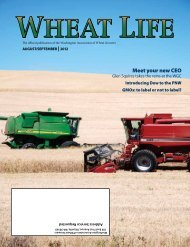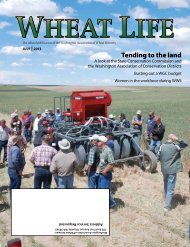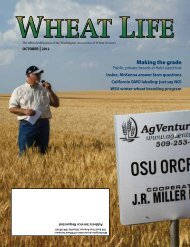Download - Wheat Life
Download - Wheat Life
Download - Wheat Life
Create successful ePaper yourself
Turn your PDF publications into a flip-book with our unique Google optimized e-Paper software.
WL<br />
WGC REPORTS<br />
EPORTS RWASHINGTON GRAIN COMMISSION<br />
A favorable forecast<br />
popular Tri-STATE CONVENTION SPEAKER GIVES CONTExt FOR WEATHER CONCLuSIONS<br />
WASHINGTON GRAIN COMMISSION<br />
By Scott A. Yates<br />
Whether it’s wheat farming or long-range weather<br />
forecasting, the end product is what’s important, but<br />
it’s the process that makes it all possible. Which may be<br />
why wheat farmers so enjoy Art Douglas’ meteorological<br />
presentations. He doesn’t just anticipate Mother Nature’s<br />
moves, he provides the context for his conclusions.<br />
Douglas, who has been traveling to<br />
the Pacific Northwest almost every<br />
year since 1979, spoke at the Tri-State<br />
<strong>Wheat</strong> Convention in late November.<br />
The Washington Grain Commissionsponsored<br />
event drew a large and<br />
appreciative audience. It didn’t hurt that<br />
Douglas’ forecast through August 2012<br />
predicted a relatively benign weather<br />
pattern of adequate, but not heavy<br />
moisture, moderate temperatures and a<br />
dry harvest period for the region.<br />
Although the future should be similar<br />
to last year, this season won’t be a repeat<br />
of 2010/11 because of a cooler than<br />
normal body of water off the Pacific<br />
Northwest coast. This phenomenon is<br />
reducing evaporation, which means<br />
fewer clouds, which means less potential<br />
precipitation. As such, Douglas<br />
predicts a smaller amount of snow in the Cascade<br />
Mountains as well as “not having excess moisture<br />
through the winter” in wheat growing areas.<br />
“You are not going to have the heavy snow cover you<br />
experienced the last few years,” he said.<br />
The main factor influencing Douglas’ forecast, however,<br />
is the reemergence of a cool body of water off the west<br />
coast of South America. Called La Niña, it will dictate<br />
world crop conditions for the next three or four months.<br />
Meteorologist Art<br />
Douglas predicts<br />
a relatively benign<br />
weather pattern for<br />
the PNW through<br />
August of 2012:<br />
•Adequate, but not<br />
heavy moisture<br />
•Moderate<br />
temperatures<br />
•A dry harvest period<br />
for the region<br />
In the Northwest, it generally means adequate moisture.<br />
Its opposite number, called El Niño, is represented by a<br />
warm body of water off the west coast of South America.<br />
When El Niño dominates, it also has implications for<br />
much of the world. In the Northwest, it signals drought.<br />
It is good news for the region, therefore, that a La Niña<br />
reasserted itself this season. Other areas of the U.S. will<br />
not be as pleased. In the Southwest,<br />
including Texas north to Kansas and<br />
Colorado, La Niña means dry weather<br />
in a section of the country already reeling<br />
from a lack of moisture.<br />
“You have to be concerned about winter<br />
wheat production in the Southern<br />
plains,” Douglas said.<br />
At the same time, he cautioned<br />
his audience of wheat farmers from<br />
Washington, Oregon and Idaho that<br />
if El Niño develops this summer, they<br />
may face drought conditions going into<br />
the fall.<br />
European climate modeling data,<br />
which Douglas believes is among the<br />
most accurate, predicts an El Niño<br />
developing this summer after the<br />
Northwest wheat crop has been made.<br />
U.S. climate modeling is not as aggressive<br />
about its strength, but also foresees an El Niño<br />
replacing the current La Niña by summer. Australian<br />
models are the exception. Last year, Australian meteorologists<br />
were predicting an El Niño that didn’t form. This<br />
year they are predicting no El Niño.<br />
Like the Northwest, Australia is frequently hammered<br />
by drought during El Niño years. If the warm water off<br />
the west coast of South America reasserts itself in the<br />
June-August time frame, wheat growers Down Under<br />
46 WHEAT LIFE JANUARY 2012










